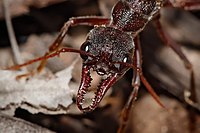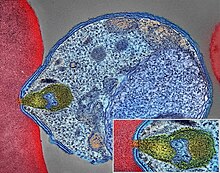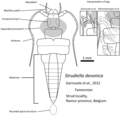Portal:Insects
The Insects Portal


Insects (from Latin insectum) are hexapod invertebrates of the class Insecta. They are the largest group within the arthropod phylum. Insects have a chitinous exoskeleton, a three-part body (head, thorax and abdomen), three pairs of jointed legs, compound eyes, and a pair of antennae. Insects are the most diverse group of animals, with more than a million described species; they represent more than half of all animal species. (Full article...)
Selected article -
Malaria is a mosquito-borne infectious disease that affects vertebrates. Human malaria causes symptoms that typically include fever, fatigue, vomiting, and headaches. In severe cases, it can cause jaundice, seizures, coma, or death. Symptoms usually begin 10 to 15 days after being bitten by an infected Anopheles mosquito. If not properly treated, people may have recurrences of the disease months later. In those who have recently survived an infection, reinfection usually causes milder symptoms. This partial resistance disappears over months to years if the person has no continuing exposure to malaria.
Human malaria is caused by single-celled microorganisms of the Plasmodium group. It is spread exclusively through bites of infected female Anopheles mosquitoes. The mosquito bite introduces the parasites from the mosquito's saliva into a person's blood. The parasites travel to the liver, where they mature and reproduce. Five species of Plasmodium commonly infect humans. The three species associated with more severe cases are P. falciparum (which is responsible for the vast majority of malaria deaths), P. vivax, and P. knowlesi (a simian malaria that spills over into thousands of people a year). P. ovale and P. malariae generally cause a milder form of malaria. Malaria is typically diagnosed by the microscopic examination of blood using blood films, or with antigen-based rapid diagnostic tests. Methods that use the polymerase chain reaction to detect the parasite's DNA have been developed, but they are not widely used in areas where malaria is common, due to their cost and complexity. (Full article...)Did you know -
- ... that the only fossil of the extinct moth Baltimartyria sat on a paleoentomologist's desk for a number of years before being described in 2011?
- ... that the extinct wasps Dryinus grimaldii and Dryinus rasnitsyni are distinguishable by the modified claws on their front legs?
- ... that the extinct planthopper Ordralfabetix is named for a character from The Adventures of Asterix?
- ... that the rove beetle Diochus electrus is the first definite member of the subfamily Staphylininae from the fossil record?
- ... that the horse fly Scaptia beyonceae was named after singer and actress Beyoncé Knowles because of its striking golden behind?
List articles
Related portals
General images -
Selected image -

Gryllotalpa brachyptera is a mole cricket (Orthoptera: Gryllotalpidae), native to Australia. Mole crickets are thick-bodied insects about 3–5 cm (1.2–2.0 in) long, with large beady eyes and shovel-like forelimbs highly developed for burrowing and swimming. The adult mole cricket may fly as far as 8 kilometres (5.0 mi) during the mating season, is active most of the year, and spends the winter in hibernation.
WikiProjects

Main WikiProject:
Related projects:
- WikiProject Arthropods
- WikiProject Spiders
- WikiProject Animals
- WikiProject Tree of Life
- WikiProject Biology
Daughter projects:
Tasks
 |
Here are some tasks awaiting attention:
|
Associated Wikimedia
The following Wikimedia Foundation sister projects provide more on this subject:
-
Commons
Free media repository -
Wikibooks
Free textbooks and manuals -
Wikidata
Free knowledge base -
Wikinews
Free-content news -
Wikiquote
Collection of quotations -
Wikisource
Free-content library -
Wikiversity
Free learning tools -
Wiktionary
Dictionary and thesaurus




















































